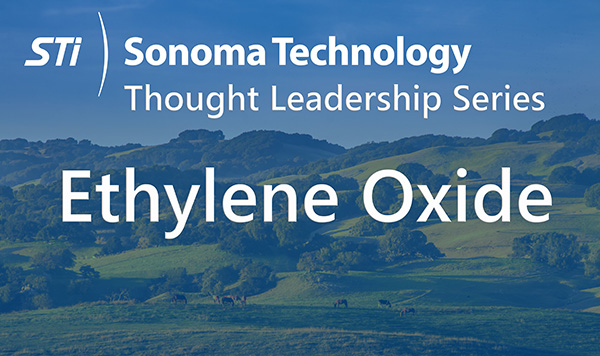Published April 2021
Ethylene Oxide in Industrial Settings
Ethylene oxide (EtO) is a highly reactive compound used in the production of detergents, thickeners, solvents, plastics, and other chemicals, the most notable of which is ethylene glycol (antifreeze). The extreme chemical reactivity of EtO makes it useful in a variety of industrial processes, but that quality also means that it poses physical and health hazards. Acute exposures to EtO may result in respiratory irritation and lung injury, headache, nausea, vomiting, diarrhea, shortness of breath, and cyanosis. Chronic exposure is associated with cancer, reproductive effects, mutagenic changes, neurotoxicity, and sensitization.
The U.S. Department of Labor Occupational Safety and Health Administration (OSHA) has established an 8-hour time-weighted average (TWA) permissible exposure limit (PEL) for occupational exposure to ambient airborne EtO of 1 part per million (ppm), or one molecule of EtO per million molecules of air. Technologies for industrial EtO monitoring need to be able to reliably detect EtO at concentrations lower than the PEL—ideally by orders of magnitude—so that chronic exposure may be more accurately assessed.
Established Monitoring Methods
Monitoring of gaseous EtO in industrial settings is commonly carried out by sampling air through sorbent tubes, which capture EtO by adsorbing it onto a target substrate. The EtO is subsequently extracted, following established methods, and analyzed by gas chromatography with a flame ionization detector (GC-FID). In general, GC analysis measures the time a compound takes to move through a column of known length and chemical composition, known as retention time, and compares it to reference standards to match the compound identity. The FID technique is well established and can detect EtO even when present in extremely small concentrations. However, the FID technique is limited in its ability to rapidly identify and quantify EtO concentrations in real time. The lower detection limit for GC-FID analysis of sorbent tube EtO samples is on the order of tens of ppb, and the time resolution is between hours and days.
Another technique for measuring EtO is the photoionization detector (PID), which ionizes sample molecules with high-energy ultraviolet light and measures the resulting current. PIDs are commonly used in leak detection and continuous air monitoring applications. The use of a GC with a photoionization detector (GC-PID) reduces the interference from other gases and can be useful for locating high concentration pockets of EtO. GC-PID monitors provide hourly measurements of EtO with detection limits of hundreds of ppb.
Emerging Technologies
Infrared (IR) absorption analyzers are increasingly of interest for EtO gas measurement. They relate the amount of light absorbed by the EtO gas at selected wavelengths to the concentration. Various IR absorption analyzers use fixed or variable filters, differing cell path lengths, and microcomputer controls to achieve greater sensitivity, automation, and interference elimination. IR absorption analyzers have detection limits ranging from hundreds of ppb down to <1 ppb and provide real-time measurements within minutes. Open-path IR absorption analyzers measure EtO between a light source and a detector, providing path-average concentrations over path lengths of several hundred meters. The lower detection limits for these analyzers depend on the path length but can range from tens to hundreds of ppb with a time resolution of minutes.
Mid-IR absorption analyzers use a similar concept in a closed cell but focus on the absorption of EtO at longer wavelengths of infrared light than other analyzers (which commonly measure in the near-IR). This greatly reduces the interference and cross-sensitivity of the EtO measurement with other gases. The sensitivity and stability of this measurement results in a lower detection limit of <1 ppb on a time scale of minutes.
Another type of IR absorption analyzer is the cavity ring-down spectrometer. Light enters a cavity with highly reflective mirrors and bounces between them. With each bounce, it is allowed to decay, or “ring-down,” along an extended “effective” path length on a short time scale. A comparison is made between the ring-down time due only to the cavity and the loss in signal due to absorption of light by a gas present in the cavity. This results in extremely stable measurements of EtO with a lower detection limit of <0.5 ppb with a time resolution of minutes.
HTMLProcess<table style="width:100%">
<tr>
<th>Measurement Technique</th>
<th>Lower Detection Limit</th>
<th>Time Resolution</th>
</tr>
<tr>
<td>Sorbent Tube & GC-FID Analysis</td>
<td>Tens of ppb</td>
<td>Hours to Days</td>
</tr>
<tr>
<td>GC-PID Analysis</td>
<td>Hundreds of ppb</td>
<td>Hours</td>
</tr>
<tr>
<td>Open-Path IR Absorption Analyzer</td>
<td>Tens to Hundreds of ppb</td>
<td>Minutes</td>
</tr>
<tr>
<td>Mid-IR Absorption Analyzer</td>
<td><1 ppb</td>
<td>Minutes</td>
</tr>
<tr>
<td>Cavity Ring-Down Analyzer</td>
<td><0.5 ppb</td>
<td>Minutes</td>
</tr>
</table>
HTMLProcess<style>
th {
color: white;
font-weight: bold;
background-color: #1f3b57;
border: 1px solid black;
padding-top: 5px;
padding-bottom: 5px;
text-align: center;
}
table {
border-collapse: collapse;
border-spacing: 0;
}
td {
border: 1px solid black;
padding-top: 5px;
padding-bottom: 5px;
padding-left: 5px;
}
</style>

Steven R. Schill

